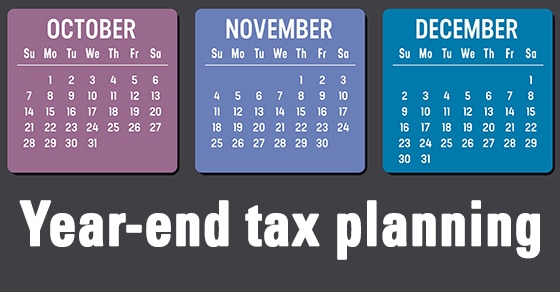The Tax Cuts and Jobs Act (TCJA) created more than 100 new tax provisions — a staggering thought as you begin to prepare for the next filing season. The good news is that these and some of the surviving provisions create a wealth of year-end planning opportunities.
Choose the right approach to deductions
Many taxpayers who’ve traditionally itemized their deductions might end up simply claiming the standard deduction for 2018. The TCJA roughly doubles the standard deduction to $12,000 for single filers and $24,000 for married couples. It also suspends personal exemptions and eliminates or limits many of the popular itemized deductions.
The deduction for state and local income and sales taxes, for example, is limited to $10,000 for the aggregate of state and local property taxes and income or sales taxes. This could make it difficult to claim enough in itemized deductions to surpass the standard deduction.
The choice between taking the standard deduction or itemizing will depend on your individual circumstances. Factors such as the amount of medical expenses could also play a role in the decision.
Time medical expenses
The TCJA gives taxpayers with substantial upcoming medical expenses strong incentive to incur them this year. The law lowered the threshold for deducting unreimbursed medical expenses from 10% of adjusted gross income (AGI) to 7.5% for all taxpayers in 2017 and 2018. Next year, though, the threshold returns to 10%, making it harder to qualify for the deduction.
Qualified medical expenses are broadly defined as the costs of diagnosis, cure, mitigation, treatment or prevention of disease and the costs for treatments affecting any part or function of the body. Examples include payments to physicians, dentists and other medical practitioners, as well as equipment (including glasses, contacts and hearing aids), supplies, diagnostic devices and prescription drugs. Travel expenses related to medical care are also deductible.
Offset capital gains
The strategy of “loss harvesting” to shield gains from the capital gains tax remains advisable for 2018, particularly for high-income taxpayers. It involves selling underperforming investments to realize losses that can offset taxable gains realized during the year. As a bonus, if the losses exceed gains, up to $3,000 of the excess losses generally can be used to offset ordinary income, which is taxed at a higher rate than capital gains. And any excess beyond that is carried forward.
You might also consider selling depreciated assets and contributing the proceeds to charity. The loss can be harvested (assuming the asset has been held for more than one year); plus, you’ll receive a charitable contribution deduction for the cash donation.
Defer income
Employees have limited options for deferring wages and salaries, but if you’re self-employed you can push income into 2019 by, for example, delaying invoices until late December so payment doesn’t arrive until January.
Regardless of your employment situation, you can also defer income by taking capital gains next year. A caveat, though — deferring income is wise only if you expect to be in the same or a lower tax bracket in 2019. If not, the taxes will be greater next year than this year.
Bunch charitable contributions
You can claim deductions for charitable contributions only if you itemize the deductions. For that reason, it’s been estimated that the number of households claiming charitable deductions will decline under the new tax law. But those with philanthropic inclinations can reap tax benefits by donating strategically.
For example, if you contribute to a donor-advised fund (DAF), you can get an immediate tax deduction. By making multiple contributions to a DAF in a single year, you can get past the standard deduction threshold and take an itemized deduction. You can direct the fund administrator to distribute the funds annually in equal increments, so your favorite charities receive a steady stream of donations regardless of whether you itemize every year. And contributing appreciated assets to a DAF (or directly to a charity) can help avoid long-term capital gains taxes (subject to certain limitations) in addition to securing a deduction for the assets’ fair market value.
If you’re not using a DAF, you can take a similar “bunching” approach to your donations to accumulate enough charitable itemized deductions to push them over the standard deduction for some years. For example, if you typically contribute to a nonprofit at the end of the year, you can instead bunch donations in alternative years (January and December of 2019 and January and December of 2021). Or you can make several years’ worth of donations in one year. You give the same aggregate amounts as in the past and preserve the charitable deduction.
Accelerate deductions
Deduction acceleration has the same goal as charitable contribution bunching: boosting the amount of deductions over the standard deduction to make itemizing worthwhile and increase the total write-off. You could accelerate deductions by prepaying state income tax or property tax bills for 2019 before year end. (Of course, this could bring the total state and local tax deduction over the $10,000 limit, meaning the sacrifice of the excess portion for tax purposes.)
However, if you’re in danger of falling prey to the alternative minimum tax (AMT), think twice before pursuing this strategy. Certain deductions allowed for the regular income tax — including those for state and local taxes — aren’t allowed for AMT purposes.
Contribute to retirement accounts
As in previous years, you can shrink your taxes by adding to tax-deferred retirement accounts. Consider the benefit of making allowable contributions to your IRAs and 401(k) plans. Also, keep in mind that, because the deadline for certain retirement account contributions is after the end of the year, there may be an opportunity for tax planning into the new year.
There’s still time
There’s much to consider under the new tax law, but one thing is certain: It’s not too late to take advantage of year-end tax planning opportunities. Turn to us for help in determining the right strategies for your situation.
© 2018




